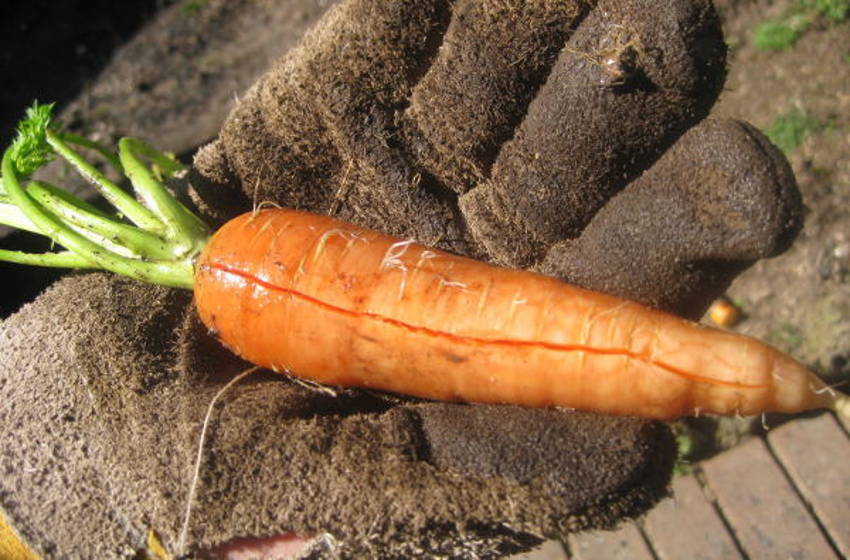It's a rare veggie grower who doesn't try carrots at least once, and it's not hard to see why this crop is so popular. Home-grown carrots are fresher and tastier than anything you'll find in the supermarkets, and there are countless varieties to try beyond the familiar orange cones.
They're also relatively easy to grow and boast a long and productive harvesting season. But despite this, growing carrots isn't entirely without its difficulties. Many gardeners sow their seeds dreaming of perfect crunchy roots, only to be dismayed at the twisted, knobbly specimens that are revealed at harvest time.
Luckily, most of the problems that carrot growers face are easily fixed. There's no dark magic involved - it's all about providing the right growing conditions and letting nature do its thing.
The Basics of Carrot Growing
Carrots should be sown directly into light, sandy, well-drained soil in full sun or partial shade. They hate being transplanted, but for an early start they can be sown in a greenhouse, in deep containers which can later be moved outdoors.
Smaller varieties can be sown from early to mid spring to provide a tender summer harvest. Larger varieties should be sown from late spring through to mid summer, for harvesting in early autumn and beyond. For a constant supply of both types, sow a small batch every two or three weeks.
Either scatter seeds thinly across the soil surface, or in rows around 15cm apart. After germination, thin the seedlings to around 8cm in each direction for scattered seeds, or around 5cm for those in rows.
This thinning is vitally important. The developing roots should never rub shoulders, as this causes many of the problems carrot growers typically encounter. Early thinnings are best done using scissors to snip the stems, avoiding damage to the root systems of the plants left behind. Later thinnings can be gently pulled whole from the soil, and the crisp baby roots used in the kitchen.
As the seedlings grow, keep them watered regularly without soaking the soil. It should take between two and three months to reach harvest.
However, this simple guide hides a few major problems. Here are nine of the main issues that can spoil your crop, along with advice on how to deal with them.
1) Failed Germination
As seedlings go, carrots are fairly weak and tender. If the soil surface is hard and compacted, the sprouting seed will struggle to break through before rotting in the soil. Prepare your soil thoroughly before sowing, raking it to a fine tilth. Cover the sown seeds with a layer of fine compost and keep it watered to prevent a crust forming.
A simple organic trick to give the seedlings a helping hand is to sow fast-growing radishes at the same time. These will soften up the soil as they sprout, and can be harvested quickly enough to not interfere with the carrots' development.
2) Forked or Twisted Roots
However, most other problems won't be apparent until harvest time. If you pull your first carrots only to find they have forked or twisted roots, the problem almost certainly lies in your soil condition. Stones, sticks, and other solid objects will force the root to grow around them, resulting in disappointingly deformed shapes. Remove as much bulky matter as you can before sowing.
Also, avoid adding manure or compost to your soil unless it is fully rotted down. Even then, make sure to mix it in thoroughly. Any changes in texture that the growing root encounters will force it off the straight and narrow.
3) Split or Cracked Roots
Although not as dramatic as forked roots, split or cracked ones are still a disappointment. This is almost always a result of inconsistent watering, particularly a heavy soaking after a dry spell. Keep the soil damp without waterlogging it, and add an organic mulch to help retain moisture.
4) Woody, Bitter Roots
Left to grow too long, especially to the stage of bolting to seed, any carrot will become tough, woody, and bitter tasting. However, this problem is made worse by inconsistent watering with periods of dryness. Once again, water a little and often, and use an organic surface mulch to protect from wind and sun evaporation.
If the roots are covered with fine hairs as well as having a woody core, excess nitrogen in the soil may also be the culprit.
5) Many Small Roots with No Main Root
However, the most common sign of excess nitrogen is the development of many small roots instead of a large central one. Carrots produce a network of fine roots to search out nutritious nitrogen as they grow. When levels are too high, these secondary roots become massively overdeveloped at the expense of the cropping root.
Avoid this by cutting back on fertiliser use, and if your soil needs feeding, use a low-nitrogen formula. Also, avoid growing carrots after nitrogen-fixing legumes in a crop rotation scheme, placing them after nitrogen-hungry brassicas instead.
6) Unusually Small or Stunted Roots
Although carrots grow best in full sun or light shade, they're highly sensitive to temperature. Sustained soil temperatures of 25C or higher will cause stunted growth and bolting to seed. Try and find a happy medium between providing enough sunlight and baking your crop, and plan your sowing for the cooler times of year if possible.
And, as with most crops, overcrowding will put a natural limit on growth, so pay careful attention to spacing and thinning.
7) Spindly Roots
On the flip side of the temperature coin, prolonged cold and lack of sun will produce weak, spindly roots - the carrot equivalent of leggy seedlings.
And again, overcrowding leads to weak and underdeveloped roots, particularly if the carrot is fighting for space against vigorous weeds. Keep your carrot bed as weed-free as possible right through from sowing to harvesting.
8) Green Tops or Cores
If the shoulder of the root is exposed to sunlight, a chlorophyll reaction will turn it green. Unlike potatoes, green carrots are safe to eat, although they'll usually be tough and bitter. Regularly check your growing carrots to make sure the roots stay under the surface, and mulch with an extra layer of fine soil if necessary.
If your carrots develop green cores, this is usually a sign of stress through changing conditions. Prolonged dryness followed by a soaking will cause this, as will a sudden heavy feed after weeks in poor-quality soil. In nearly all aspects of cultivation, carrots love consistency and moderation.
9) Carrot Fly
Most carrot growers encounter carrot fly at some point. The eggs they lay develop into hungry maggots which quickly lay waste to the roots. Luckily, deterring this pest is usually straightforward.
Carrot flies have a maximum cruising altitude of around 30cm, so sowing in raised beds puts your crop out of reach. Alternatively, companion planting with garlic, chives, or leeks will drive the pest away through the strong allium aroma.
If the problem persists, cover the entire patch with fine netting, making sure it reaches right down to the soil. Also, avoid thinning or harvesting your crop on windy days, as the chemicals this releases will attract carrot flies from far and wide.
None of these problems should deter you from growing carrots. So long as you provide the right soil conditions and keep on top of watering, you'll be rewarded with a fruitful harvest of sweet, crunchy roots from early summer to late autumn and beyond.







